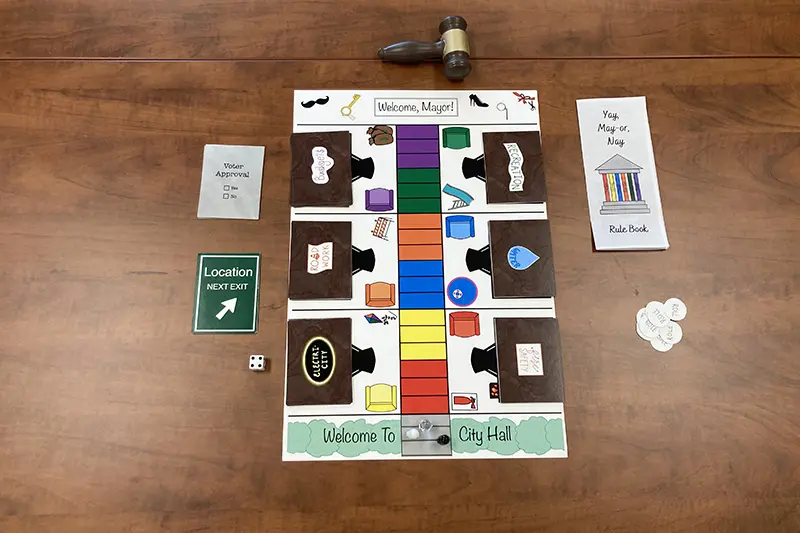Taylor’s Mathematics Department equips students to pursue their passions while also making an impact in the broader community. Our students graduate years ahead in their field as the department provides countless opportunities at home and abroad to expand their research experience. At Taylor, students not only explore the intricacies of mathematics but also its connection to Christian faith.
Over the summer, Math Education majors Anne Parker ‘24 and Emily Odell ‘24 received invaluable experience working alongside Dr. Derek Thompson, the Department Chair and Professor of Mathematics, to design their own creative projects, all with unique connections to math.
Summer Mathematics Research at Taylor
Our award-winning Mathematics faculty are the driving force behind our successful department. They believe in treating students as full-fledged mathematicians to communicate trust and instill confidence.
“There is a lot about learning how to learn that you get by doing research on an idea,” Thompson said.
Originally Parker and Odell set out to come up with a strategy for a classroom math game using a Pop-It (a popular fidget toy with kids), but by the end of the summer they had completed nearly five different projects. These projects included a redesign of the Math Interaction Area in the Euler Science Complex, the creation of a political board game, cards to use with the game Codenames for math concepts, among others.
The Original Research Project: Pop-Its
Pop-Its can be found in all shapes and sizes and are loved by kids across America. But the designers of the product originally engineered Pop-Its to act as a board game that teaches math concepts.
The rules of the game are simple: pop as many spots in a row and take turns until all the spots are popped. The object of the game is to not be the one who pops the last spot on the board. Players are able to adjust the difficulty level based on various rules.
The original problem for Parker and Odell was to solve what is called a “solid strategy” in math. The pair solved the strategy within two days, as well as presented a research poster on their findings.
Math, Politics, and More
Next, Parker and Odell were interested in constructing a classroom game that discreetly teaches high school students how to form a logical argument. Created to be interdisciplinary in nature, this game can be played in a variety of classroom settings including math (especially geometry), government, speech, or grammar.
Called “Yay, May-or, or Nay,” the objective is for your team to advance on the board from City Hall to the Mayor’s office before the other team does. Players move forward through answering a series of logic-based questions.
“The majority of the questions are intentionally open-ended, " Parker said. “Which means that as long as you and your team can support the answer you give, it will pass.”
One unique player position, called the Council Master, plays a mediator role in which they oversee judging the answers that each team provides and determine whether or not the team can move ahead.
The game is meant to mimic the local politics without bringing up major hot button issues. With six possible locations to choose from, each game played will be different depending on the city chosen; examples include Chicago, IL; Juneau, AL; and Upland, IN.
Odell said that she has seen a need for engaging activities that teachers can implement into their classrooms. This project came out of her own personal desire to see less note taking and more puzzles and brain teasers that engage students experientially.
Taylor’s Mission for Reaching the Community
The team’s long-term vision was to make this game accessible for local teachers to integrate into their classrooms.
“The driving question behind all the research done this summer was, ‘What can we do to provide resources to teachers for free?’” Thompson said.
To increase accessibility, the students created print files of the game along with written instructions about the game process. They hung up posters with a QR code attached that sends the user straight to these files.
The team originally decided to tailor their game towards high school students, since that is the time geometry is introduced in curriculum, which is usually students’ first introduction to arguments. They were also able to test out the game on real high school students from the local community.
“Geometry is where you learn about proofs and how to make convincing arguments to back up your rational thought,” Parker said.
Typically, proofs are among the hardest mathematical concepts for students to grasp. Thompson believes this is the case because proofs introduce a written and logical justification component that students have not yet encountered in math.
“I think a lot of students go into geometry and think of drawing shapes and doing the measurements, while missing the importance of proofs,” Thompson said.
Through the Yay, May-or, Nay game, students are learning how to make real world “proofs” as they form a solid argument, grappling with real issues that affect our communities.
Explore Mathematics at Taylor University
From creating one-of-a-kind research opportunities to connecting students with resume-building internships, Taylor's Mathematics Department goes the extra mile to help students excel. Click here to learn more about the opportunities in Taylor’s Mathematics Department.

